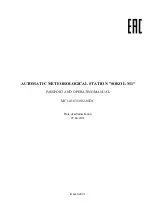
PORTABLE S.A.M.E. WEATHER RADIO
MODEL: WR102
INSTRUCTION MANUAL
INTRODUCTION
Thank you for purchasing the WR102 Portable SAME (Specific Area Message Encoding) Weather Radio. The
WR102 is a multi-function device that operates on the same radio frequencies used by the NOAA (National Oceanic
Atmospheric Administration) Weather Radio (NWR). The WR102 warns users of severe weather and other
environmental dangers. Ideal for back-packers or individuals who spend extended periods of time in remote
locations; this device is also equipped with a digital clock and daily alarm.
The WR102 is designed for individuals and organizations that require dependable early-warnings of weather or
environmental dangers. This is the first portable take anywhere weather radio that operates on batteries or AC
power. A low battery warning icon alerts users that batteries are low and need replacing. The WR102 is small,
lightweight and constructed of durable materials. With a reception range up to 40 miles, the WR102 is ideal for use
in remote outdoor areas and in densely populated areas such as schools, hospitals or offices.
The 2-line liquid-crystal display (LCD) is easy to read. The electro-luminescent (EL) backlight ensures that night
time warnings are seen and properly interpreted.
To optimize your use of the WR102, please read this manual before use. Should you require additional assistance
or information, please contact our Customer Service Department at 800-853-8883 or via email at:
helpme@oscientific.com.
ABOUT THE NATIONAL WEATHER-RADIO SYSTEM
The National Weather Service (NWS) is an agency within the National Oceanic & Atmospheric Administration
(NOAA) that operates a nationwide network of radio stations known as the NOAA Weather Radio (NWR). The NWR
radio system broadcasts warning information for all types of hazards both natural and technological. Working in
conjunction with the Emergency Alert System (EAS), NWR is considered to be the most comprehensive
emergency information system.
A nationwide network, the NWR consists of more than 480 stations in the United States, Puerto Rico, the U.S. Virgin
Islands and U.S. Pacific Territories. Broadcasts are designed to meet local needs. Routine programming is
repeated every few minutes and consists of local forecast, regional conditions and marine forecasts. Additional
information, including river stages and climatic data, is also provided. During emergencies, these routine
broadcasts are interrupted to report specific warnings, watches or other critical information.
dh/5/15/2000/final website
































